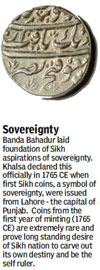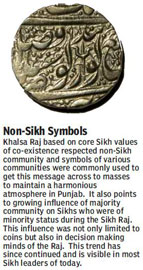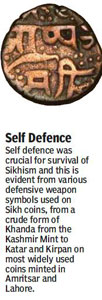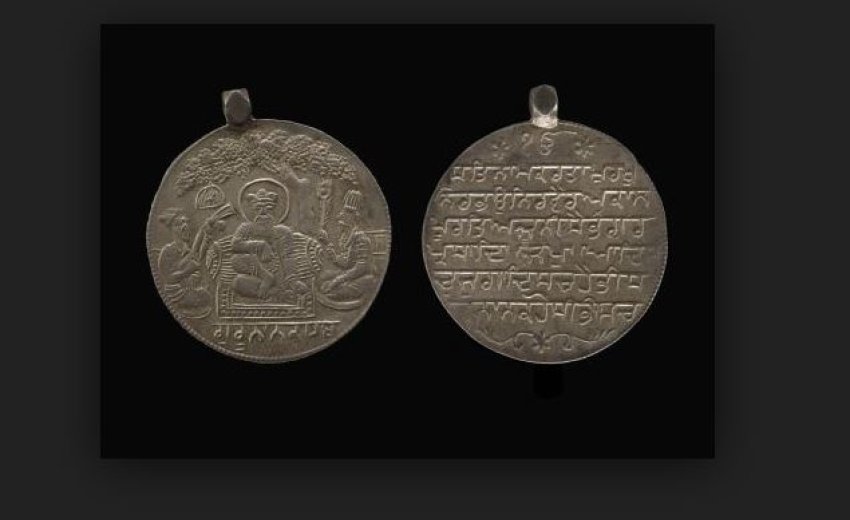 World Sikh News is pleased to present a peep into the vast coin collection of Jatinder Singh Hundal and it would be interesting to see know if his collection of Sikh coins is matched by anyone else as he has a sample collection of virtually most of the coins minted during all the years of the Sikh Misl period and that of the Sikh Raj.
World Sikh News is pleased to present a peep into the vast coin collection of Jatinder Singh Hundal and it would be interesting to see know if his collection of Sikh coins is matched by anyone else as he has a sample collection of virtually most of the coins minted during all the years of the Sikh Misl period and that of the Sikh Raj.
Following the collapse of Sikh Empire in 1849 due to intrigue and deception by the Dogras on the one hand and infighting of the Royal family on the other, the Sikh monetary system was replaced by the British. This sudden interruption of the Sikh financial system sent a shock wave in the market system of Punjab, and Sikh coins that were backbone of this system saw a sudden and large scale decline in their value.
The treasury of the Sikh empire was forced to de-value Sikh coins that ended up being sold for the metal rather than the face value. Mints were busy melting and moulding the Copper, Silver and Gold coins into metal for sale in the open market. The free market system forced them to melt the metal for its intrinsic value than to exchange it for something from a government treasury. This is the prime cause for unavailability of lesser number of Sikh coinage to collectors and students of Sikh Numismatics.
Whenever and wherever the question of Sikh sovereignty is brought into discussion, serious students of history and culture cannot afford to miss the connection to Sikh coinage. In contemporary times, 1984 marked a watershed. Since 1984, there has been a renewed interest in studies about the Sikh Empire as the Sikhs were painfully repeatedly reminded of how the Sikh self-rule of the nineteenth century was snatched out of their hands.  The younger generation among the Sikhs, especially those living in developed economies of Europe and North America, with resources at their disposal have shown a renewed interest in the field of Sikh Coins as a mean to connect them with the glorious part of their history –the Sikh Raj.
The younger generation among the Sikhs, especially those living in developed economies of Europe and North America, with resources at their disposal have shown a renewed interest in the field of Sikh Coins as a mean to connect them with the glorious part of their history –the Sikh Raj.
Collections: Most Sikh coins continue to be in private collections or to a lesser extent in museums of Punjab. Even India’s national museums continue to ignore Sikh coins as they are seen a challenge to the Indian state as it exists today. Most international museums display Sikh Empire coins under the larger “Indian Collection”. This makes it difficult for a student of such coins to focus on Sikh coins as they formed a small portion of the larger “Indian Collection”.
Even Sikh institutions, such as SGPC and Punjab government have paid little or no attention in this area. The exhibition of coins by the SGPC in the Darbar Sahib complex, maintained by the SGPC and those of the government of Punjab in its museums in Chandigarh and Amritsar do not do justice to the Sikh Empire. The vast and diversified collection of the Sikh Raj and the genius behind its monetary system have been totally undermined in these exhibitions and they purposely do not paint a true picture of the erstwhile Sikh nation.
While the government and semi-government institutions may have failed, individual Sikhs have take to the field like fish to water and have assumed the gigantic responsibility of preservation of the heritage of the Sikh through numismatics. They have not only shown interest but have painstakingly started to collect and study Sikh coins.
Study of Sikh Coins: In the last two decades, a couple of good books have been published by those who have done a study of Sikh coins. The first was “Coins of the Sikhs” by Hans Herrli, published by Indian Coin Society Nagpur in 1993. Its second revised and better formatted edition was published by Munshiram Manohar Lal (ISBN: 81-215-1132-1) in 2004. Chandigarh based Surinder Singh’s work, “Sikh Coinage: A symbol of Sikh Sovereignty” was also published in 2004 by Manohar Publishers and Distributors (ISBN: 81-7304-533-X).
Both books are full of pictures and illustrations to explain the Sikh Empire coins and sometime go into details that may make it sound more like a text book rather than a coffee table edition. Yet, both offer insight in the mints, coin types, metals, symbols, writing, dates and other associated details that are important for a collector, dealer or student of Sikh coins.
Devotion of a community: Sikh coins can be found in Copper, Silver and Gold and bear some interesting marking to identify the mint. Coins from the mint of Derajat have a lion while the Amritsar Mint had weapons such as Kirpan and Katar as decorations to signify the importance of self defence in Sikhism. A crude form of Khanda (with one sword and one Chakar) can also be seen on some of the coins produced in the Kashmir mint.
It is a Sikh belief that one must seek protection of the Almighty God. This theme is prevalent in many Sikh coins minted in the Amritsar mint, with the words “Akal Sahai” inscribed on them.
As the city of Amritsar was seen as a center of Sikhism, its name was used on several coins from the city. The name of the city of Amritsar appears to be the only name of a city found on the Sikh coins. It appears as “Sri Amritsarji”
Sikhs throughout history have attributed their success to God Almighty -Waheguru. The path to Waheguru is shown by the Gurus and all achievements of the community are seen as blessings of the Guru. This is seen in almost every Sikh coin ever produced. The following couplet, appearing on the coins in Farsi dominates this theme: Deg Tegh O Fateh Nusrat Bedirang, Yaft Az Nanak Guru Gobind Singh
Deg Tegh O Fateh Nusrat Bedirang, Yaft Az Nanak Guru Gobind Singh
meaning, “Kettle to feed, (with) the sword to defend, (and) the resultant victory are achieved with help from Guru Nanak -Guru Gobind Singh.”
Living with and respecting nature: Several students of Sikh coins have attributed the decoration of the coins with a leaf as unique to Khalsa Raj time. However, that does not seem to be true since several coins of the Sikh Misl era also have a leaf as an ornament for decoration.
Various types of leaves found in Punjabi countryside have been used. This signifies the Sikh respect for nature and a balanced life. Recognition of flora and fauna found in the nature is stressed in Guru Granth Sahib and Sikh coins have carried that philosophy into daily economic life by having these leaves form part of the coins in circulation.
Expansion of Sikh Empire: The distribution of mints across the empire provides clues to the expanding Sikh Raj from Lahore to other parts of the South Asia. Upto late 1770’s, only Lahore Mint was used whereas the Amritsar mint started production of Sikh Misl coins around 1777.
Between 1782 and 1797, there appear to be no Sikh coins produced by Lahore mint. This is due to the fact that during this period Lahore became a dangerous territory as a struggle between the Khalsa and the Punjab Government made Lahore unsuitable. Most economic activity seems to have been effected by it.
As Sikhs shifted to safer grounds, away from Lahore, the Anandgarh Mint was used between 1784 and 1789, while the Amritsar mint also produced coins during this period. Several researchers of Sikh coins are of the opinion that the Anandgarh mint was only in name while actually it was the Amritsar mint, which produced the coins. It is quiet probable that the name of Anandgarh was used as a camouflage.
From 1798 to 1817, both Amritsar and Lahore were the main minting locations. By 1820, Sikh Raj was on a strong ground and its expansion is evident from the fact that from 1818, the Multan mint became active and very many fine examples of the coins minted there have survived the devastation of Punjab.
Brahman Influence: The Dogras and Brahmins had infiltrated the upper echelons of the Sikh Empire and were the cause of the downfall of the empire in 1849. The influence of Hindu thought on the decision makers of the Lahore Darbar is evident from the coins of later part of Sikh Raj. Immediately after the death of Maharaja Ranjit Singh in 1839, the Sikh Kingdom came under the control of the Dogras and most coins minted during Maharaja Sher Singh (1841-1843) contain figures of the Hindus. The most widely used are OM and a pictorial representation of Trishul.
Till the end of the Sikh Raj: From 1835 to the end of Sikh Raj, Kashmir, Multan, Derajat and Peshavar mints were active in the production of Sikh Coins. There were other smaller mints throughout the newly acquired territory, but these major mints kept the treasury going for the most part. The Amritsar Mint was the only mint that produced Sikh coins from 1777 to end of the Sikh Raj in 1849.
Hailing from village Bundala, near Jandiala Guru in Amritsar and tracing his lineage to Baba Hindal -during the times of the third Sikh master, Guru Amardas Ji, the author-numismatist Jatinder Singh Hundal is a suave Panthic volunteer who participates keenly in all religio-political and human rights activities, but by choice remains non-aligned.  An organiser of Gurmat camps for children and a volunteer-teacher at the local Sikh school in California; he is the founder member of Sikh Youth of America and the Worl Sikh Organisation. A trained engineer based in Sacramento, California, he is an avid student and collector of Sikh coins and also a keen collector of manuscripts. He possesses a well documented library on Sikh literature containing more than ten thousand books, some as old as 1880.
An organiser of Gurmat camps for children and a volunteer-teacher at the local Sikh school in California; he is the founder member of Sikh Youth of America and the Worl Sikh Organisation. A trained engineer based in Sacramento, California, he is an avid student and collector of Sikh coins and also a keen collector of manuscripts. He possesses a well documented library on Sikh literature containing more than ten thousand books, some as old as 1880.
He is a much traveled person having visited many a country of the world, except India. We are pleased to announce that he would write regularly for World Sikh News. He may be contacted at [email protected].
Join the Sikh Coins Group: http://groups.yahoo.com/group/SikhCoins/
Numismatics is the study or collection of currency, including coins, tokens, paper money, and related objects. While numismatists are often characterized as students or collectors of coins, this study also includes a much larger study of payment media used to resolve debts and the exchange of goods. Without a structured monetary system, many societies used locally produced/found items of value as an exchangeable currency.
Sikh Numismatics is a new area of study with growing interest among young and educated Sikhs, especially in Diaspora where a connection is made with glorious past though coins of that era. Even though, several individuals have taken on this study seriously, there are no defined groups, societies, associations etc. devoted to Sikh coins and tokens. This is starting to change as internet has brought like minds together; for example the Yahoo Sikh Coins Group.
It is a fact that many Sikhs and non Sikhs around the world are not aware that the Sikh Empire known as Punjab covered a huge area in the North/West of India. The Punjab used a very fascinating monetary system consisting of coins in metals of Copper, Silver and Gold.
The coins were minted in denominations of Paisa, Rupee and Mohur covering the major cities of Punjab viz Amritsar, Kashmir, Anandghar which are still part of India, apart from Lahore (Capital of the old Punjab), Multan, Peshawar which are now in modern day Pakistan. Today well-known collectors continue to study Sikh coins to attribute them to mint towns and cities which were previously not known.
The sovereign Sikh rule by Maharaja Ranjit Singh began in 1801, the Sikhs had established control over Lahore in 1765 itself and had started minting and circulating their own coins. Despite the large and very interesting variety of coins which were circulated over a large territory for more than eighty years, the study of Sikh coins – the symbols of Khalsa Sovereignty, has mainly remained neglected.
Jatinder Singh Hundal works with The Sikh Coins Group, dedicated to academic and intellectual interaction on Sikh Numismatics, including the numismatics of CIS Sutlej States such as Nabha, Patiala, Kaithal and Malerkotla.
The Sikh Legacy Through Numismatics

